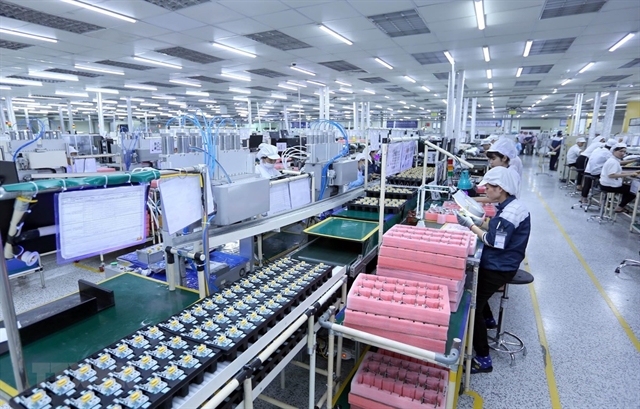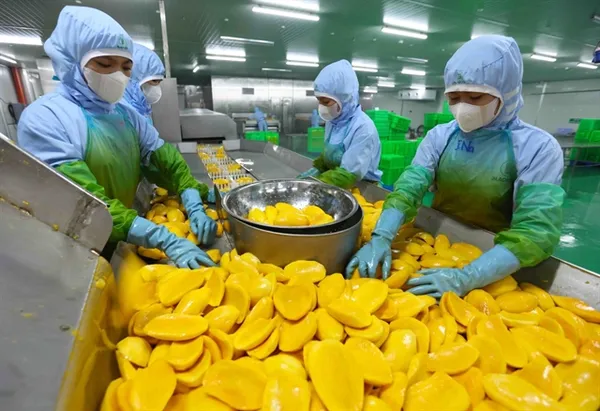 Economy
Economy

 |
| Electronic circuit board produced at Nexcon Việt Nam. There were significant opportunities for electronics part-supply industry to make a change amid a global production shift. — VNA/VNS Photo Danh Lam |
HÀ NỘI — As the global production shift intensifies, remarkable prospects for transformation present themselves within the electronic parts supply industry, according to the Việt Nam Association for Supporting Industries (VASI).
This current trend is a call for enterprises to innovate and integrate into global supply chains.
The association's Deputy President, Đỗ Thị Thuý Hương, delineates a somewhat uneven development within the electronics support sector. She reveals that a substantial 73 per cent of exports are phone-related. Following closely are integrated circuits, pivotal in the manufacturing of computers and peripherals. These form the backbone of Việt Nam's electronics supporting industry.
Over the past ten years, the electronics sector and its ancillary industries have played a significant role in boosting Việt Nam's export turnover, accounting for more than 30 per cent of the nation's export value in 2021-22.
The industry's impact is not only felt in export numbers. It also contributed to a healthy balance of trade for Việt Nam.
In 2021, the country reported a trade surplus of $4 billion, with the electronics industry contributing a substantial surplus of $11.5 billion. Although a slight downturn was noted in 2022 with figures of $11.2 billion and $11.24 billion, respectively, the industry's role in assuring a balance of foreign exchange and trade for Việt Nam remains undeniable. This noted downturn is attributed to a global economic slowdown experienced in 2022.
Hương said that the COVID-19 pandemic and conflicts between major economies were reshaping the global supply chain. However, firms must make drastic efforts to enhance competitiveness to grasp the opportunities from the global production shift.
The association said that enterprises operating in the supporting industry were mainly of small and medium size with limited capital and human resources, citing statistics that those with capital of below $1 million accounted for 26 per cent and $1-5 million 26 per cent.
Although there were significant improvements in recent years, such as more than 200 Vietnamese firms becoming suppliers for Samsung, the electronics supporting industry was facing considerable challenges.
The first challenge was that policies failed to keep pace with development.
Changes in consumption habits and behaviours required Việt Nam to adjust policies in supporting enterprises and attracting foreign investment to ensure a high-quality foreign investment inflow. However, the adjustments were not timely enough.
Việt Nam was also at risk of lagging behind the rapid development of Industry 4.0, forcing enterprises to shift to innovation-driven development, especially in the context that cheap labour and the availability of natural resources were no longer advantages, she said.
Besides, there were serious shortages of skilled workers, capital and technology to receive advanced technologies value transfer from FDI inflow.
Climate change and unsustainable resource exploitation were also having a strong impact on Việt Nam’s sustainable development goals.
According to the Ministry of Industry and Trade, the digital transformation at Vietnamese enterprises operating in the electronics industry was happening at a low speed. Most firms used computers but at the level of normal applications and lacking in-depth applications. Around 20 per cent of the total number of firms were willing to invest in digitalisation.
In 2023, although the world economy was in a mild recession and inflation was passing its peak, it was now the time when businesses and people felt its impact the most, the association said. Commodity prices fell, but consumer demand did not increase, especially for electronics products.
Of note, after the COVID-19 pandemic, new consumer habits and behaviours were being formed with a preference for online shopping and more attention to the practical application of electronic products and devices.
Hương said that firms should use these changes to adjust their production orientations and capacity,
Vũ Trọng Tài, general director of RX Tradex Việt Nam, said that there were opportunities and challenges intertwined, urging firms to make fast transitions to take the opportunities.
The global production shift was creating opportunities for enterprises to participate in the global supply chains and increase added value as well as for Việt Nam to attract more FDI.
The enforcement of new-generation free trade agreements, including the Comprehensive and Progressive Trans-Pacific Partnership (CPTPP) and the EU – Việt Nam FTA (EVFTA), also created favourable conditions for trade and investment in high-tech industries, especially electronics.
Tài pointed out that the challenge was that most of Việt Nam’s supporting industry was of small and medium size firms, so their production was fragmented with low technology, limited productivity and quality not up to requirements.
Meanwhile, the supply chains had not been established firmly and synchronised and remained discrete.
Opportunities came quickly but passed quickly. India was growing rapidly with the plan to regain its position as a leading manufacturing hub from China.
It was a good time for Việt Nam to promptly make innovations to embrace the opportunities and accelerate the digitalisation process while the Government needed to timely adjust policies to promote the development of supporting industries and enable enterprises to participate in the global supply chains in higher tech positions. — VNS




